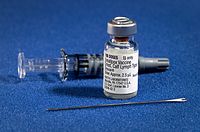
Photo from wikipedia
Background Vaccination is considered as most efficient strategy in controlling SARS-CoV-2 pandemic spread. Nevertheless, patients with autoimmune inflammatory rheumatic diseases receiving rituximab (RTX) are at increased risk to fail humoral… Click to show full abstract
Background Vaccination is considered as most efficient strategy in controlling SARS-CoV-2 pandemic spread. Nevertheless, patients with autoimmune inflammatory rheumatic diseases receiving rituximab (RTX) are at increased risk to fail humoral and cellular responses upon vaccination. The ability to predict vaccination responses is essential to guide adequate safety and optimal protection in these patients. Methods B- and T- cell data before vaccination were evaluated for characteristics predicting vaccine responses in altogether 15 patients with autoimmune inflammatory rheumatic diseases receiving RTX. Eleven patients with rheumatoid arthritis (RA) on other therapies, 11 kidney transplant recipients (KTR) on regular immunosuppression and 15 healthy controls (HC) served as controls. A multidimensional analysis of B cell subsets via UMAP algorithm and a correlation matrix were performed in order to identify predictive markers of response in patients under RTX therapy. Results Significant differences regarding absolute B cell counts and specific subset distribution pattern between the groups were identified at baseline. In this context, the majority of B cells from vaccination responders of the RTX group (RTX IgG+) were naïve and transitional B cells, whereas vaccination non-responders (RTX IgG-) carried preferentially plasmablasts and double negative (CD27-IgD-) B cells. Moreover, there was a positive correlation between neutralizing antibodies and B cells expressing HLA-DR and CXCR5 as well as an inverse correlation with CD95 expression and CD21low expression by B cells among vaccination responders. Summary Substantial repopulation of the naïve B cell compartment after RTX therapy appeared to be essential for an adequate vaccination response, which seem to require the additional capability of antigen presentation and germinal center formation. Moreover, expression of exhaustion markers represent negative predictors of vaccination responses.
Journal Title: Frontiers in Immunology
Year Published: 2022
Link to full text (if available)
Share on Social Media: Sign Up to like & get
recommendations!